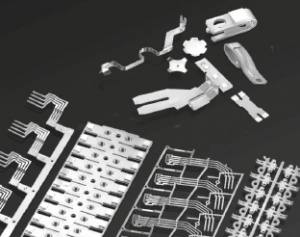Manufacturing Technologies for Contact Parts
Besides the selection of the most suitable contact materials, the design and type of attachment is critical for the reliability and electrical life of contact components for electromechanical switching devices. The most important factors here are the material-saving use of precious metals and the most economical manufacturing method for contact parts..
There are two basic manufacturing solutions available: One can start with single contact parts, such as contact rivets or tips, which then are attached mechanically or by brazing or welding resp. to carrier parts. In the second case, a base material coated or clad with the precious contact metal - for special applications also clad with another non-precious material – in the form of strips or profiles is manufactured as a semi-finished pre-material from which the contact components are then stamped and formed. Besides mechanical cladding other processes such as electroplating and deposition from the gas phase are utilized. Which of the following manufacturing processes is finally chosen, depends on the final application of the contact components in their respective switching devices or electromechanical components. Other considerations, such as the required number of electrical operations, the most economical use of precious metals and the anticipated volumes of parts are also important for the process selection.
Contents
Manufacturing of Single Contact Parts
The group of single contacts includes contact rivets, contact tips and formed parts such as weld buttons. Contact spheres (or balls) are today rarely used because of economical considerations.
Main Articel: Manufacturing of Single Contact Parts
Manufacturing of Semi-Finished Materials
Semi-finished contact pre-materials can be manufactured from solid precious metals, precious metal alloys or precious metal containing composite materials.
Main Articel: Manufacturing of Semi-Finished Materials
Attachment of Single Contact Parts
The following segments give an overview of the usually applied attachment technologies for contact parts to carrier components. They include mechanical, as well as brazing and welding methods used for electrical contact assemblies.
Main Articel: Attachment of Single Contact Parts
Evaluation of Braze or Weld Joints
The switching properties of brazed and welded contact assemblies is strongly dependent on the quality of the joint between the contact and the carrier. The required high quality is evaluated through optical methods, continuous control of relevant process parameters and by sampling of finished products.
Main Articel: Evaluation of Braze or Weld Joints
Stamped Contact Parts
Stamped electrical contact parts typically consist of a base carrier material to which a contact material is attached by various methods (Figure 1). They serve as the important functional components in many switching and electromechanical devices for a broad range of electrical and electronic applications. On the one hand, they perform the mostly loss-free electrical current transfer and the closing and opening of electrical circuits, while on the other hand, the contact carriers are important mechanical design components, selected to meet the requirements on electrical, thermal, mechanical and magnetic properties.
The increasing miniaturization of electromechanical components requires ever smaller stamped parts with low dimensional tolerances. Such precision stamped parts are needed in the automotive technology for highly reliable switching and connector performance. In the information and data processing technology, they transfer signals and control impulses with high reliability and serve as the interface between electronic and electrical components.
Main Articel: Stamped Contact Parts
References
Vinaricky, E. (Hrsg.): Elektrische Kontakte, Werkstoffe und Anwendungen. Springer-Verlag, Heidelberg, Berlin 2002
Witter, G., J.; Horn, G.: Contact Design and Attachment in: Electrical Contacts. Hrg.: Slade, P., G., Marcel Dekker, Inc.,New York, Basel, 1999
Mürrle, U: Löten und Schweißen elektrischer Kontakte. In: Werkstoffe für elektrische Kontakte und ihre Anwendungen: Hrg.: Schröder K.-H. u. a.; Expert-Verlag, Band 366, (1997), 146 - 175
Eisentraut, H.: Verbundwerkstoffe aus der Walze. Kaltwalzplattieren von Mehrschichtverbundhalbzeugen, Metall 48 (1994) 95-99
Weik, G.: Kontaktprofile ganzheitliche Lösungen für elektrische Kontaktsysteme, Metall 61 (2007) H. 6, 399 403
Jinduo, F; Guisheng, W.; Fushu, L.; Hongbing, Z.; Wenland, L.: Study on Reliability of AuAg10/AgNi10/CuNi30 Micro Contacts, th Proc. 24th Int. Conf.on Electr. Contacts, Saint Malo, France 2008, 206-209
Dorn, L.: Grundlagen der Löttechnik. in: Hartlöten Grundlagen und Anwendungen. Hrsg.: Dorn, L. u.a., Expert-Verlag, Band 146 (1985) 15-40
Schreiner, H.: Güte der Lötung bzw. Schweißung von Kontaktstücken auf dem Trägermetall - Prüfung und Beurteilung nach dem Beschalten im Prüfschalter. Metall 30 (1976) 625 - 628
DVS-Merkblatt 2813: Widerstandsschweißen von elektrischen Kontakten, Düsseldorf: DVS-Verlag 2009
Schneider, F.: Stöckel, D.: Schweißen in der Kontakttechnik. Zts. für wirtschaftliche Fertigung 72, (1977) H. 4 u. 6
Haas, H.; Martin, W.; Tschirner, U.: Widerstandsschweißen in der Elektrotechnik, VDE-Fachbericht 42 (1991) 113-121
Weik, G.: Widerstandsschweißen von Kontaktprofilen mit Nachsetzwegmessung, VDE-Fachbericht 63 (2007) 165-174
Bolmerg, E.: Aufschweißtechnik von Kontakten in Hinblick auf ihre Anwendung. VDE-Fachbericht 51 (1997) 103-109

